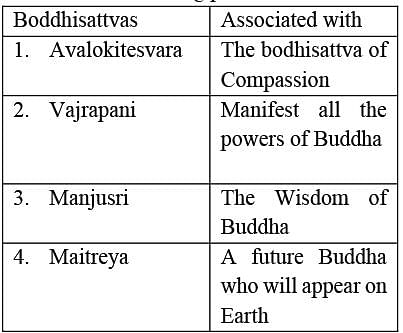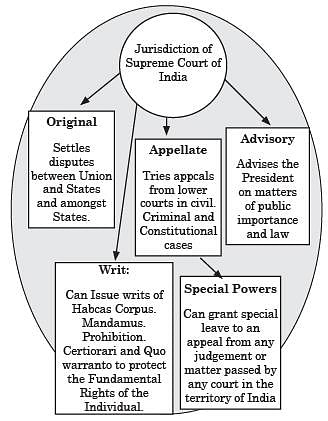UPSC CSE Complete Practice Test - 5 - UPSC MCQ
30 Questions MCQ Test Mock Test for UPSC Prelims 2025 - UPSC CSE Complete Practice Test - 5
Consider the following pairs :

How many of the above pairs are correctly matched?

How many of the above pairs are correctly matched?
Consider the following statements with respect to cell division:
- Mitotic cell division occurs in somatic cells only and meiosis occurs in germ cells only.
- All mitotic progeny are genetically similar whereas in meiosis, a new combination of genes is obtained.
Which of the statements given above is/are correct?
| 1 Crore+ students have signed up on EduRev. Have you? Download the App |
Consider the following statements:
Statement-I: Maximum density of water is achieved at 4 degrees celsius.
Statement-II: Specific heat of water is maximum at 4 degrees celsius.
Which one of the following is correct in respect of the above statements?
Funds availed under Kisan Credit Card (KCC) scheme can be used by farmers for which of the following purposes?
- Post-harvest expenses
- Consumption requirements of farmers household
- Short-term credit requirements for cultivation of crops
- Working capital for maintenance of farm assets and activities allied to agriculture, like dairy animals, inland fishery etc.
- Produce Marketing Loan
- Investment credit requirement for agriculture and allied activities like pump sets, sprayers, dairy animals etc.
How many of the statement(s) given above is/ are correct?
Which of the following statements best describes the term 'Allelopathy'?
Consider the following statements.
- ASEAN-India Trade in Goods Agreement (AITIGA) is a free trade pact among the ten member states of the Association of Southeast Asian Nations (ASEAN) and India.
- Under the pact, the two trading partners set timelines for eliminating duties on the maximum number of goods traded between the two regions.
- A review of AITIGA is held annually at the ASEAN-India Economic Ministers’ meeting to make trade facilitative and mutually beneficial.
How many of the above statements are correct?
With reference to the processes under nitrogen cycle, consider the following pairs:
Process : Function
1. Nitrification : Conversion of nitrates in to gaseous nitrogen
2. Assimilation : Conversion of gaseous nitrogen into ammonia
3. Ammonification : Conversion of nitrogenous waste products and dead organisms into inorganic ammonia
4. Denitrification : Conversion ammonia nitrates or nitrites
How many of the above pairs are correctly matched?
Consider the following statements:
- Absolute poverty does not concentrate on biological needs but rather makes a comparison between two people in the society.
- Income Level is considered in absolute poverty but it is not considered when measuring relative poverty.
- World Bank defines the extreme poor as those living on less than $1.90 a day.
Which of the above statements is/are correct?
With reference to the Biodiversity coldspots, consider the following statements:
1. They are the areas where the fitness of at least one of the two species is determined by interactions with the other.
2. Coldspots are relatively empty and have unstable environments.
3. They are better equipped to handle diversification of species than tropical areas.
How many of the above statements are correct?
With reference to Indian Universities Act, 1904, consider the following statements:
- It was setup based on the recommendations of Raleigh Commission.
- Five crore rupees were to be sanctioned per annum for five years for improvement of higher education and universities.
- The conditions were to be made stricter for affiliation of private colleges.
How many of the statements given above is/are correct?
Which of the following is the aim of the National Land Records Modernization Programme (NLRMP) initiated in 2008?
Consider the following statements regarding Yasuni National Park, recently seen in news.
- Yasuni National Park is one of the world’s most biodiverse regions.
- It is located in Brazil.
- The area is inhabited by the Tagaeri and Taromenani, who live in self-isolation.
- It was designated a world biosphere reserve by the UNESCO.
How many of the above statements are correct?
Consider the following:
- Camphor
- Cellulose
- Iodine
How many of the above compounds undergo sublimation that is transitioning directly from the solid phase to the gas phase without passing through the liquid phase?
What happens to the electrical conductivity of a semiconductor when it is exposed to light?
Which among the following rulers issued coins with a ship motif, indicating the importance of overseas trade during his reign?
Consider the following pairs of Indo-French Joint Exercises.
- Garuda: Army exercise
- Varuna: Naval exercise
- Shakti: Air exercise
How many of the above options is/are correct?
With reference to Central Emergency Response Fund (CERF), consider the following statements:
- It was established by the UN General Assembly to provide rapid and life-saving assistance to vulnerable populations during humanitarian crises.
- It is managed by the Office for Disaster Risk Reduction on behalf of the UN Secretary-General.
- It releases resources for underfunded emergencies twice a year.
How many of the above statements given is/are correct?
Which of the following particles has the least mass?
The Good Friday Agreement seen recently in the news was signed between which of the following countries?
With reference to heating and cooling of the atmosphere, consider the following statements:
1. The process of vertical heating of the atmosphere is known as advection.
2. The transfer of heat through the horizontal movement of air is called convection.
Which of the statements given above are correct?
With reference to the Supreme Court of India, consider the following statements:
1. The Court comprises the Chief Justice and not less than 33 other Judges.
2. Judges must have been at least fi ve years as a Judge of a High Court.
3. The appointment of a Judge of a High Court may appoint as an Ad-hoc Judge of the Supreme Court.
How many of the above statements are correct?
Consider the following statements.
- Earth spins around an imaginary axis which passes through the north pole, its centre of mass and the south pole.
- Rocks slowly circulating inside Earth’s mantle causes the planet’s mass to shift, leading to a change in the position of the rotational axis.
- Ocean currents and even hurricanes are also responsible for the change in the position of the earth’s rotational axis.
How many of the above statements are correct?
Which of the following statements is/are correct?
1. Each trophic level has a certain mass of living material at a particular time called as the standing crop.
2. The standing crop is measured as the mass of living organisms (biomass) or the number in a unit area.
Choose the correct option using the code given below.
With reference to The Economics of Ecosystems and Biodiversity (TEEB), consider the following statements:
1. It is a global initiative focused on “making nature’s values visible”.
2. It finds its institutional home at the United Nations Environment Programme in Geneva.
3. Recently, the Government of India launched the TEEB-India Initiative at G20, 2023 summit.
Which of the statements given above is/are not correct?
Regarding the appointment of High Court Judges, consider the following statements:
1. The President ensures the transfer of Chief Justice from one High Court to another.
2. The process of appointment must be completed at least 15 days prior to the date of anticipated vacancy for the Chief Justice of the High Court.
Which of the above statements is/are correct?
Consider the following statements:
1. The Amendment procedure has been provided in Article 368 of the Constitution of India.
2. The consent of the States is mandatory for all Amendments to the Constitution of India
Which of the statements given above is/are correct?
Public goods in India refer to goods and services that are provided by the government and are available to the general public without any exclusion or rivalry. In this context, consider the following:
1. Public schools and universities
2. Law enforcement agencies
3. All India Radio and Doordarshan
4. Social Security Programs
How many of above-mentioned is/are incorrect?
Consider the following statements:
1. When Income increases, the demand curve shifts upwards for all goods.
2. The decrease in sales for a product attributed to shift towards cheaper alternatives in market.
Which of the statements given above are correct?
Consider the following statements:
1. The Supreme Court has only original and appellate jurisdiction.
2. Its exclusive original jurisdiction extends to any dispute between the Government of India and one or more States.
Which of the above statements is/are correct?
Consider the following:
1. Indica
2. Mahavamsa
3. Ritusamhara
4. Mudrarakshasa
How many of the above are the literary sources for the Mauryan empire?
|
16 videos|4 docs|70 tests
|
|
16 videos|4 docs|70 tests
|


















